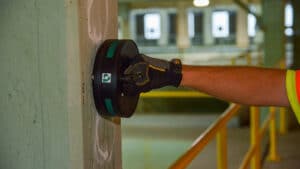Find an office location
More than 175 offices from coast to coast.
Non-destructive concrete testing is a good starting point for building owners looking to redesign or expand, or for owners seeking needed or preventive maintenance to extend the life of structures. The ability to effectively diagnose hidden issues beyond the surface of hardened concrete with limited damage not only saves significant time and money on a project, but can also identify potential problems that may develop over the service life of the structure. Differences in environment, materials, and construction all impacts construction materials in unique and sometimes unforeseen ways. Utilizing various non-destructive testing technology and laboratory techniques, Terracon teams deliver the results of materials tests, accurately and timely, enabling us to help clients make informed decisions before undergoing repairs.
When investigating the condition of your site, Terracon can use the latest technologies to assess reinforcing steel corrosion and concrete issues. Collectively, these assessments allow our engineers to test a much larger area on-site, and in a shorter timeframe than destructive methods, helping us provide our customers with a more complete picture of the building or structure investigation.

iCor testing
When more information is needed, Terracon’s scientists rely on our nationwide network of more than 140 laboratories that are accredited to perform further testing.
Petrographic analysis is the choice for building owners who need more information on the structural integrity, properties, and characteristics of the concrete. It can be used to evaluate the effects of concrete after being exposed to freeze/thaw, fire, chemical attacks, alkali-silica reactivity, or carbonation, which lowers the pH level of concrete and can lead to an increased risk of reinforcement corrosion. In addition, petrographic examination is a proven way to thoroughly investigate possible construction or material defects.
With petrographic analysis, samples are analyzed under a microscope, allowing the tester to ‘see’ through concrete when sections 25 microns thick (approximately half the width of human hair) are used. This thorough method meets multiple ASTM standards (see Table I below).
Terracon’s tensile testing meets three ASTM standards (see Table I below), measuring the tensile yield, elongation, and reduction area of rebar and other materials by tensioning it to the breaking point. Our facilities are capable of testing materials up to No. 18 rebar, which measures 2.25 inches in diameter.
Table I – Relevant ASTM Standard for Field and Laboratory Testing
| Test | ASTM standard |
| Half-cell corrosion testing | C876 |
| Impact Echo testing | C1383 |
| Petrographic analysis | C295, C457 and C856 |
| Tensile testing | E8, A615, and A706 |
Unmanned Aircraft Systems, or drone technology, makes elevated work safer by providing unmanned visual inspections. Drones are also a valuable tool because they can assist in other areas.

Unmanned aircraft systems are a useful tool.
Distress mapping on ceilings and other hard-to-reach places is simpler with software that stiches together multiple images for a clearer view. Onboard cameras also have 180-degree views, ideal for capturing the undersides and top of various structures in high-resolution images that can be analyzed.
The Terracon team may not use all these testing methods on every project, but they are available. Our engineers and scientists use these methods to identify potential issues and develop a phased approach for each unique building issue to plan the maintenance and repair.
Wil Beckwith, P.E., is a materials engineering manager in Terracon’s Cincinnati, Ohio, office. His team, which specializes in both new and old materials testing, routinely analyzes materials from all 50 states and several foreign countries each year.
More than 175 offices from coast to coast.